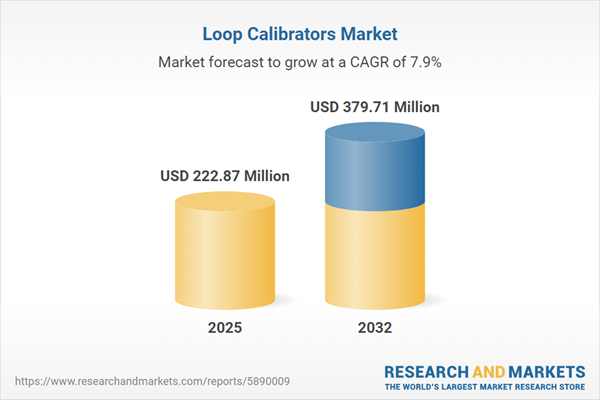Speak directly to the analyst to clarify any post sales queries you may have.
The loop calibrators market is transforming industrial process management, with advanced calibration solutions enhancing accuracy, reliability, and compliance across diverse end-user environments. As industries face increasing demands for quality and digitalization, modern loop calibrators are becoming indispensable for process control leaders seeking operational excellence.
Market Snapshot: Loop Calibrators Driving Precision and Compliance
The Loop Calibrators Market grew from USD 206.32 million in 2024 to USD 222.87 million in 2025. It is expected to continue growing at a CAGR of 7.92%, reaching USD 379.71 million by 2032. Heightened regulatory demands and complex automation requirements across petrochemical, pharmaceutical, power generation, and water sectors continue to propel adoption and innovation in this market.
Scope & Segmentation of the Loop Calibrators Market
This report provides a comprehensive examination of the entire loop calibrator ecosystem, with rigorous analysis structured across multiple segmentation layers and global regions:
- Product Types: Four-wire and two-wire loop calibrators, catering to diverse accuracy and installation needs.
- End Users: Chemicals & petrochemicals, food & beverage (alcoholic beverages, bakery & confectionery, dairy), mining (metal, mineral), oil & gas (downstream, midstream, upstream), power generation (nuclear, renewables, thermal), water & wastewater (industrial, municipal).
- Communication Standards: Foundation Fieldbus (H1, HSE), HART, PROFIBUS (DP, PA), wireless protocols (ISA100.11a, WirelessHART).
- Calibration Services: Off-site services (corrective, preventive), on-site services (emergency, scheduled).
- Sales Channels: OEM, aftermarket (direct, distributor).
- Accuracy Tiers: Up to 0.02 percent, 0.02 to 0.05 percent, and above 0.05 percent, enabling alignment with specific process tolerances.
- Regions Covered: Americas (North America, Latin America), Europe, Middle East & Africa, Asia-Pacific, including leading and emerging industrial markets spanning the United States, China, India, Germany, Brazil, and more.
- Leading Providers: In-depth coverage of key companies such as Fluke Corporation, Emerson Electric Co., Siemens Aktiengesellschaft, ABB Ltd, Yokogawa Electric Corporation, Testo SE & Co. KGaA, Ametek Inc., Additel Corporation, Megger Group Limited, Automation Technologies, Inc.
Key Takeaways for Senior Decision-Makers
- Digital transformation and the Industrial IoT are elevating loop calibration from a compliance obligation to a central element of operational optimization, with predictive analytics and real-time monitoring mitigating unplanned downtime.
- Demand is increasingly shaped by industry-specific requirements—such as ruggedness in mining, hygiene in food & beverage, and traceability in power generation—driving manufacturers to deliver customized solutions for each vertical.
- Remote calibration technologies, including wireless protocols and augmented reality troubleshooting, address both technician safety and logistical challenges in hazardous or geographically dispersed operations.
- Regulatory pressures are accelerating the adoption of advanced calibrators that support digital recordkeeping, firmware updates, and multi-protocol communications to simplify audit readiness and certification processes.
- Competitive strategies are shifting as market leaders focus on portfolio innovation, localized manufacturing, and comprehensive service offerings, while mergers, acquisitions, and partnerships enable faster response to regional needs.
Tariff Impact on Loop Calibrator Market Dynamics
- Recently imposed tariffs in the United States have significantly impacted supply chain strategies, prompting market participants to reassess sourcing and favor regional or nearshore suppliers to minimize cost exposure.
- Manufacturers and service providers are adapting through product redesigns for more favorable tariff classifications, as well as by increasing domestic calibration lab investments to maintain customer service continuity amidst lead time pressures.
- Contract models are evolving, with bundled maintenance and longer-term agreements shaping procurement in light of higher cost layers and inventory adjustments across distribution channels.
Methodology & Data Sources
This analysis leverages a robust multi-stage methodology, integrating primary interviews with executives and engineers, secondary validation from industry literature and regulatory databases, and quantitative modeling. Scenario analyses and expert peer-review underpin the reliability of insights for decision-making.
Why This Report Matters
- Enables leadership to align loop calibration strategies with digital transformation and sustainability objectives, reducing risk and optimizing operational performance.
- Supports procurement and market planning by clarifying segmentation, regional dynamics, and technology adoption patterns in the loop calibrator ecosystem.
Conclusion
This report provides actionable intelligence for stakeholders navigating technological, regulatory, and economic shifts in the loop calibrators market. Strategic insights empower decision-makers to manage risks, capture new opportunities, and sustain growth.
Additional Product Information:
- Purchase of this report includes 1 year online access with quarterly updates.
- This report can be updated on request. Please contact our Customer Experience team using the Ask a Question widget on our website.
Table of Contents
3. Executive Summary
4. Market Overview
7. Cumulative Impact of Artificial Intelligence 2025
Companies Mentioned
The companies profiled in this Loop Calibrators market report include:- Fluke Corporation
- Emerson Electric Co.
- Siemens Aktiengesellschaft
- ABB Ltd
- Yokogawa Electric Corporation
- Testo SE & Co. KGaA
- Ametek Inc.
- Additel Corporation
- Megger Group Limited
- Automation Technologies, Inc.
Table Information
| Report Attribute | Details |
|---|---|
| No. of Pages | 199 |
| Published | October 2025 |
| Forecast Period | 2025 - 2032 |
| Estimated Market Value ( USD | $ 222.87 Million |
| Forecasted Market Value ( USD | $ 379.71 Million |
| Compound Annual Growth Rate | 7.9% |
| Regions Covered | Global |
| No. of Companies Mentioned | 11 |









